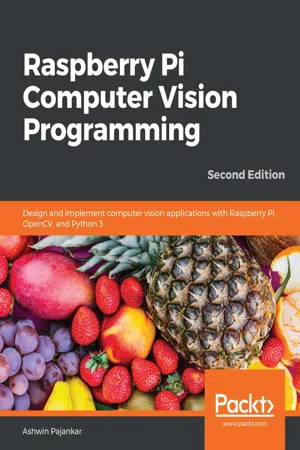
Raspberry Pi Computer Vision Programming
Design and implement computer vision applications with Raspberry Pi, OpenCV, and Python 3, 2nd Edition
- 306 pages
- English
- ePUB (mobile friendly)
- Available on iOS & Android
Raspberry Pi Computer Vision Programming
Design and implement computer vision applications with Raspberry Pi, OpenCV, and Python 3, 2nd Edition
About this book
Perform a wide variety of computer vision tasks such as image processing and manipulation, feature and object detection, and image restoration to build real-life computer vision applications
Key Features
- Explore the potential of computer vision with Raspberry Pi and Python programming
- Perform computer vision tasks such as image processing and manipulation using OpenCV and Raspberry Pi
- Discover easy-to-follow examples and screenshots to implement popular computer vision techniques and applications
Book Description
Raspberry Pi is one of the popular single-board computers of our generation. All the major image processing and computer vision algorithms and operations can be implemented easily with OpenCV on Raspberry Pi. This updated second edition is packed with cutting-edge examples and new topics, and covers the latest versions of key technologies such as Python 3, Raspberry Pi, and OpenCV. This book will equip you with the skills required to successfully design and implement your own OpenCV, Raspberry Pi, and Python-based computer vision projects.
At the start, you'll learn the basics of Python 3, and the fundamentals of single-board computers and NumPy. Next, you'll discover how to install OpenCV 4 for Python 3 on Raspberry Pi, before covering major techniques and algorithms in image processing, manipulation, and computer vision. By working through the steps in each chapter, you'll understand essential OpenCV features. Later sections will take you through creating graphical user interface (GUI) apps with GPIO and OpenCV. You'll also learn to use the new computer vision library, Mahotas, to perform various image processing operations. Finally, you'll explore the Jupyter Notebook and how to set up a Windows computer and Ubuntu for computer vision.
By the end of this book, you'll be able to confidently build and deploy computer vision apps.
What you will learn
- Set up a Raspberry Pi for computer vision applications
- Perform basic image processing with libraries such as NumPy, Matplotlib, and OpenCV
- Demonstrate arithmetical, logical, and other operations on images
- Work with a USB webcam and the Raspberry Pi Camera Module
- Implement low-pass and high-pass filters and understand their applications in image processing
- Cover advanced techniques such as histogram equalization and morphological transformations
- Create GUI apps with Python 3 and OpenCV
- Perform machine learning with K-means clustering and image quantization
Who this book is for
This book is for beginners as well as experienced Raspberry Pi and Python 3 enthusiasts who are looking to explore the amazing world of computer vision. Working knowledge of the Python 3 programming language is assumed.
Frequently asked questions
- Essential is ideal for learners and professionals who enjoy exploring a wide range of subjects. Access the Essential Library with 800,000+ trusted titles and best-sellers across business, personal growth, and the humanities. Includes unlimited reading time and Standard Read Aloud voice.
- Complete: Perfect for advanced learners and researchers needing full, unrestricted access. Unlock 1.4M+ books across hundreds of subjects, including academic and specialized titles. The Complete Plan also includes advanced features like Premium Read Aloud and Research Assistant.
Please note we cannot support devices running on iOS 13 and Android 7 or earlier. Learn more about using the app.
Information
Chapter 1: Introduction to Computer Vision and the Raspberry Pi
- Understanding computer vision
- Single-board computers
- The Raspberry Pi family of single-board computers
- Setting up the Raspbian OS on a Raspberry Pi
- Connecting various Pi board models to the internet with LAN or Wi-Fi
Understanding computer vision

- The recognition of objects, the classification of visual detection, and an analysis of motion
- The reconstruction of scenes using images
- Image denoising and restoration
OpenCV
Table of contents
- Raspberry Pi Computer Vision Programming
- Second Edition
- Preface
- Chapter 1: Introduction to Computer Vision and the Raspberry Pi
- Chapter 2: Preparing the Raspberry Pi for Computer Vision
- Chapter 3: Introduction to Python Programming
- Chapter 4: Getting Started with Computer Vision
- Chapter 5: Basics of Image Processing
- Chapter 6: Colorspaces, Transformations, and Thresholding
- Chapter 7: Let's Make Some Noise
- Chapter 8: High-Pass Filters and Feature Detection
- Chapter 9: Image Restoration, Segmentation, and Depth Maps
- Chapter 10: Histograms, Contours, and Morphological Transformations
- Chapter 11: Real-Life Applications of Computer Vision
- Chapter 12: Working with Mahotas and Jupyter
- Chapter 13: Appendix
- Other Books You May Enjoy